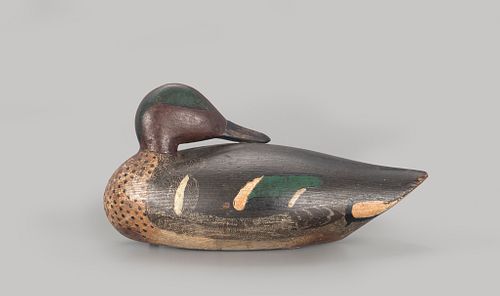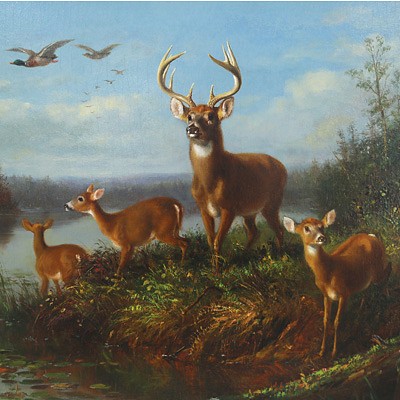Early Preening Green-Winged Teal Decoy by Chase Littlejohn (1853-1943)
Lot 151
About Seller
Copley Fine Art Auctions
20 Winter Street
Pembroke, MA 02359
United States
Founded in 2005, Copley Fine Art Auctions is a boutique auction house specializing in antique decoys and American, sporting, and wildlife paintings. Over the course of the last two decades, the firm has set auction records for not only individual decoy makers, but also entire carving regions. Copley...Read more
Estimate:
$15,000 - $20,000
Absentee vs Live bid
Two ways to bid:
- Leave a max absentee bid and the platform will bid on your behalf up to your maximum bid during the live auction.
- Bid live during the auction and your bids will be submitted real-time to the auctioneer.
Bid Increments
| Price | Bid Increment |
|---|---|
| $0 | $50 |
| $1,000 | $100 |
| $2,500 | $250 |
| $5,000 | $500 |
| $10,000 | $1,000 |
| $25,000 | $2,500 |
| $50,000 | $5,000 |
About Auction
By Copley Fine Art Auctions
Feb 24, 2023
Set Reminder
2023-02-24 10:00:00
2023-02-24 10:00:00
America/New_York
Bidsquare
Bidsquare : The Winter Sale 2023, Day 1
https://www.bidsquare.com/auctions/copley/the-winter-sale-2023-day-1-11939
Lots 1-337 Copley Fine Art Auctions cinnie@copleyart.com
Lots 1-337 Copley Fine Art Auctions cinnie@copleyart.com
- Lot Description
Early Preening Green-Winged Teal
Chase Littlejohn (1853-1943)
Redwood City, CA, c. 1885
10 in. long
"A more interesting fellow than Chase Littlejohn has probably never existed."This is the opening line to the carving legend's chapter in "Wildfowl Decoys of California."This early teal and its rigmates remain the only known Littlejohn decoys to have come to light. He is recognized as one of California's earliest makers.
Over 110 years ago, Littlejohn, a California native, was fascinating his contemporaries with his hunting and natural history adventures. "The San Francisco Sunday Call" ran a page 2 profile feature in 1909 titled "A Hunter of Rare and Unusual Game: Chase Littlejohn Has bagged Sea Otters in Japan, Big Game in Alaska & Strange Birds Everywhere."Today, among decoy collectors, he is most remembered for his early and important green-winged teal rig.
The maker's avocations as a naturalist and a taxidermist clearly gave him the anatomical knowledge necessary to accurately carve this preening green-winged teal. The bird is in a deep preening pose with a refined bill resting back on the right wing. The carving is finished with detailed feathering, including combed vermiculation on the sides. The carving's rectangular weight is attached using about forty brass tacks. The underside of the hollow body also bears a tidy leather anchor line tie.
Original paint with light wear.
Provenance: William C. McMaster M.D. Collection
Literature: Joe Engers, "Early California green-winged teal turn up at West Coast collectibles show,"Decoy Magazine, March/April 1997, p. 14, exact decoy illustrated. Michael R. Miller, "Wildfowl Decoys of California,"Spokane, WA, 2015, p. 358, rigmates illustrated. H. A. Crafts, "A Hunter of Rare and Unusual Game," The San Francisco Sunday Call, June 27, 1909, p. 2, rigmates illustrated.Please email condition report requests to colin@copleyart.com. Any condition statement given is a courtesy to customers, Copley will not be held responsible for any errors or omissions. The absence of a condition statement does not imply that the lot is in perfect condition.Condition
- Shipping Info
-
Shipping info
Copley does not offer in-house packing or shipping. For clients who require shipping, please complete the Shipping Release Form and return it with your payment. The form includes a list of shippers we frequently work with.
-
- Buyer's Premium



 EUR
EUR CAD
CAD AUD
AUD GBP
GBP MXN
MXN HKD
HKD CNY
CNY MYR
MYR SEK
SEK SGD
SGD CHF
CHF THB
THB
















